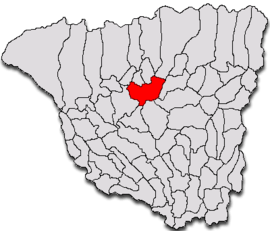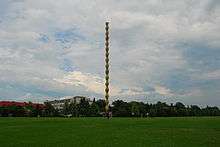Târgu Jiu
Târgu Jiu (Romanian pronunciation: [ˌtɨrɡu ˈʒiw]) is the capital of Gorj County in the Oltenia region of Romania. It is situated on the Southern Sub-Carpathians, on the banks of the river Jiu. Eight localities are administered by the city: Bârsești, Drăgoieni, Iezureni, Polata, Preajba Mare, Romanești, Slobozia and Ursați.
Târgu Jiu | |
|---|---|
Downtown | |
 Coat of arms | |
 Location in Gorj County | |
 Târgu Jiu Location in Romania | |
| Coordinates: 45°2′3″N 23°16′29″E | |
| Country | |
| County | Gorj |
| Established | 1406 (first official record as Jiul) |
| Subdivisions | Bârsești, Drăgoieni, Iezureni, Polata, Preajba Mare, Romanești, Slobozia, Ursați |
| Government | |
| • Mayor | Marcel Romanescu[1] (PNL) |
| Area | 102 km2 (39 sq mi) |
| Population (2011)[2] | 82,504 |
| • Density | 810/km2 (2,100/sq mi) |
| Time zone | EET/EEST (UTC+2/+3) |
| Postal code | 200xyz |
| Area code | +40 x53 |
| Vehicle reg. | GJ |
| Website | www |
History

The city takes its name from the river Jiu, which runs through it. In antiquity, there was a Dacian village in around the location of today's city surrounded by forests. After the Roman conquests of Oltenia (101-102), military units were stationed around the roads that connected different important routes at the time. During the digging of the Târgu Jiu - Rovinari railroad, mosaics, coins, ceramics and Roman bricks were found in the south-eastern part of the city.[3] This and ancient testimonies support the idea that Târgu Jiu was a commercial town (a vicus) while under the Roman Empire's rule. A very important route that connects the Danube to Transylvania runs through the city, so historians believe that part of the Roman army under Trajan's leadership stayed and then passed in the actual location of the city.
After the 271 withdrawal of the Roman army, the city remained in the Latin influence zone, mainly because of Constantine The Great's involvement in Oltenia which he sought to bring under imperial rule. The importance of keeping this zone under Rome's control was underlined by Constantine's decision to build a second bridge over the Danube between today's Corabia (then Sucidava) and the Bulgarian city of Gigen. It was over 2400 meters long, one of the longest of all time.
This territory was under Litovoi's rule, a Vlach (Romanian) voivode in the 13th century, whose territory comprised northern Oltenia. He is mentioned for the first time in a diploma issued by king Béla IV of Hungary (1235–1270) on 2 July 1247. In 1277 (or between 1277 and 1280), Litovoi was at war with the Hungarians over lands King Ladislaus IV of Hungary (1272–1290) claimed for the crown, but for which Litovoi refused to pay tribute. Litovoi was killed in battle.
The first written account of the city appears in a document dating from 23 November 1406 in an order signed by Mircea cel Batran. Since 1497, the city has been the seat of Gorj County.
Constantin Brâncuși, who had lived here as a boy, was commissioned to contribute to a memorial monument to the fighters of World War I, called Calea Eroilor, "Heroes' Street", which was finished in 1938. His large sculptures are now the main tourist attractions in Târgu Jiu: The Table of Silence, Stool Alley, The Gate of the Kiss, and The Endless Column. The latter is shown in the middle section of the city's coat of arms.
In the 1950s the Communist mayor planned to demolish Brâncuși's "bourgeois" art. The plan was not carried out.
Starting in the 1960s, coal surface mining contributed to a rapid population growth. Other local industries include wood, machine building, textiles, glassware and construction materials (cement, bricks and tiles).
In 1992, a university was founded and named after Brâncuși.
Coat of arms
The Coat of Arms of Târgu Jiu consists of a Shield with seven towers. In the centre of the Shield lies the representation of Constantin Brâncuși's Endless Column, a symbol of Romanian art and culture. In the right and left sides of the shield lies a golden lion holding a black sword, "guarding" the Column. The Lion is the ancient symbol of Oltenia, thought to be originating from the logo of one Rome's Legions station in this aria, the 13th Legion "Gemina (Legio XIII Gemina)". It represents the bravery and combative spirit of the city's inhabitants.
Population
- 1889: 4,076
- 1900: 6,634
- 1940: 26,634
- 2002: 96,641
- 2011: 80,548
As of 2011 census, 78,553 inhabitants live within the city limits:[4] 96,29% were Romanians (75,640 people), 3,41% Gypsies or Roma people (2.683 people) and 0,20% others.
Transport
- The public transport system of Târgu Jiu consists of 2 trolleybus lines and 8 bus lines. It is operated by S.C. Transloc. S.A. A ticket for one trip costs around €0.5.
- The main railway station is situated on Republicii Blvd. It was reconstructed within the last 25 years.
- The city's road network consists of five boulevards (Blvd. Constantin Brâncuși, Blvd. Nicolae Titulescu, Blvd. Republicii, Blvd. Ecaterina Teodoroiu, Blvd. Unirii). The main street of the city is Calea Victoriei (Victory Avenue). The largest boulevard in Târgu Jiu is Blvd. Ecaterina Teodoroiu.
- Târgu Jiu is crossed by many important roads, such as E 79 and DN 67.
Gallery
 The Endless Column by Constantin Brâncuși
The Endless Column by Constantin Brâncuși Gate of the Kiss by Constantin Brâncuși
Gate of the Kiss by Constantin Brâncuși City Hall
City Hall Holy Voivodes Church and Gorj County Prefecture
Holy Voivodes Church and Gorj County Prefecture- Central Park
- Palace of Finance, today Constantin Brâncuși University
- Tudor Arghezi Library
Education
Main high schools are:
- National College "Ecaterina Teodoroiu"
- National College "Tudor Vladimirescu"
- National College "Spiru Haret"
- Colegiul Comercial "Virgil Madgearu"
- Colegiul Tehnic "General Gheorghe Magheru"
- Scholar Group Energetic Nr. 1"
The universities are:
Sports
The main football team of the city is Pandurii. They have spent 12 season in the country's top league, Liga I. Their best result was achieved in the 2012–13 season, when they came in second. Pandurii has qualified for European competitions on two occasions, and reached the group stages of the 2013–14 UEFA Europa League.
Also, the city has one basketball team in Liga Națională, CSM Târgu Jiu and two handball team in Divizia A, UCB Târgu Jiu, at male's and CSM Târgu Jiu, at female's.
Twin cities





Natives
- Ioan Bengliu, general
- Ioan Culcer, general
- Adrian Ioana, mathematician
- Grigore Iunian, politician
- Mihail Lascăr, general
- Horațiu Mălăele, actor
- Vasile Martinoiu, opera singer
- Sergiu Nicolaescu, actor and film director
- Constantin Petrovicescu, soldier and politician
- Gheorghe Tătărescu, lawyer and prime minister
- Ecaterina Teodoroiu, World War I heroine
- Emil Ungureanu, chess International Master
See also
References
- "Rezultate alegeri partiale locale. PSD castiga Craiova, PNL Roman si Târgu Jiu" (in Romanian). Mediafax. 12 June 2017. Retrieved 3 April 2020.
- "Populaţia stabilă pe judeţe, municipii, oraşe şi localităti componenete la RPL_2011" (in Romanian). National Institute of Statistics. Retrieved 4 February 2014.
- Ministerul Culturii şi Patrimoniului Naţional, Lista Monumentelor Istorice, 2010 Archived 2012-06-10 at the Wayback Machine
- "Recensamantul populatiei si Locuintelor 2011" (PDF) (in Romanian). INSSE. 2 February 2012. Archived from the original (PDF) on 21 January 2016. Retrieved 8 March 2012.
External links
| Wikimedia Commons has media related to Târgu Jiu. |
- . Encyclopædia Britannica (11th ed.). 1911.